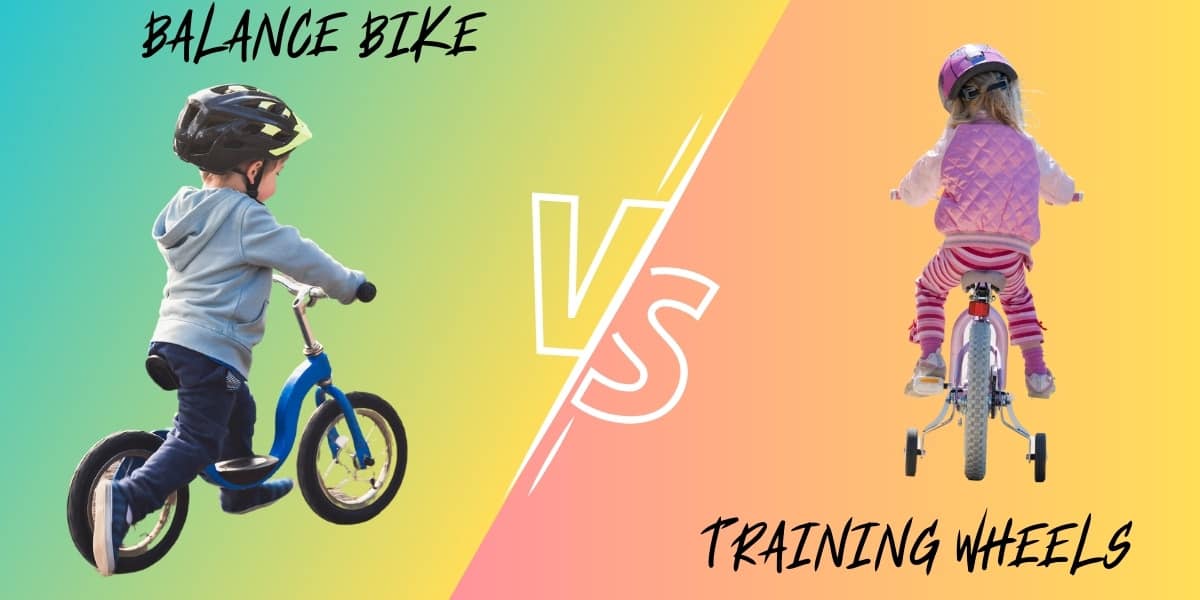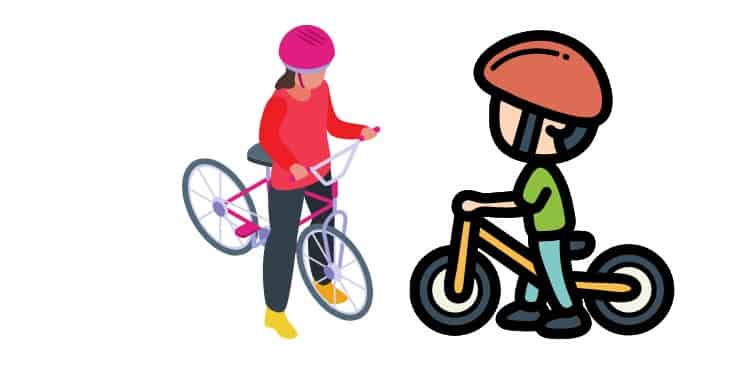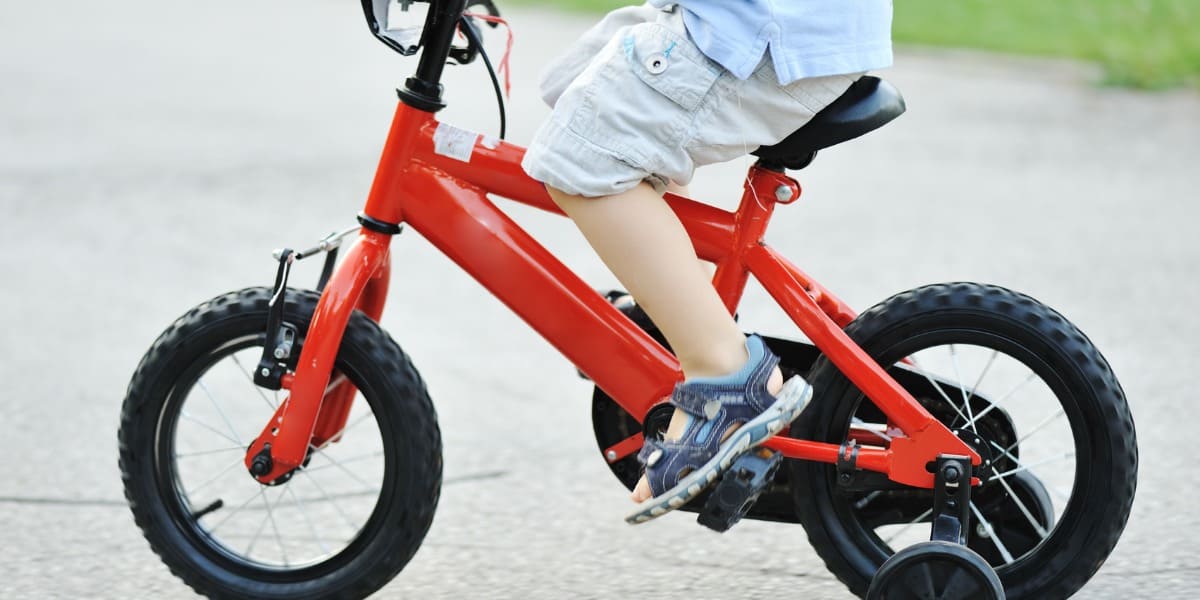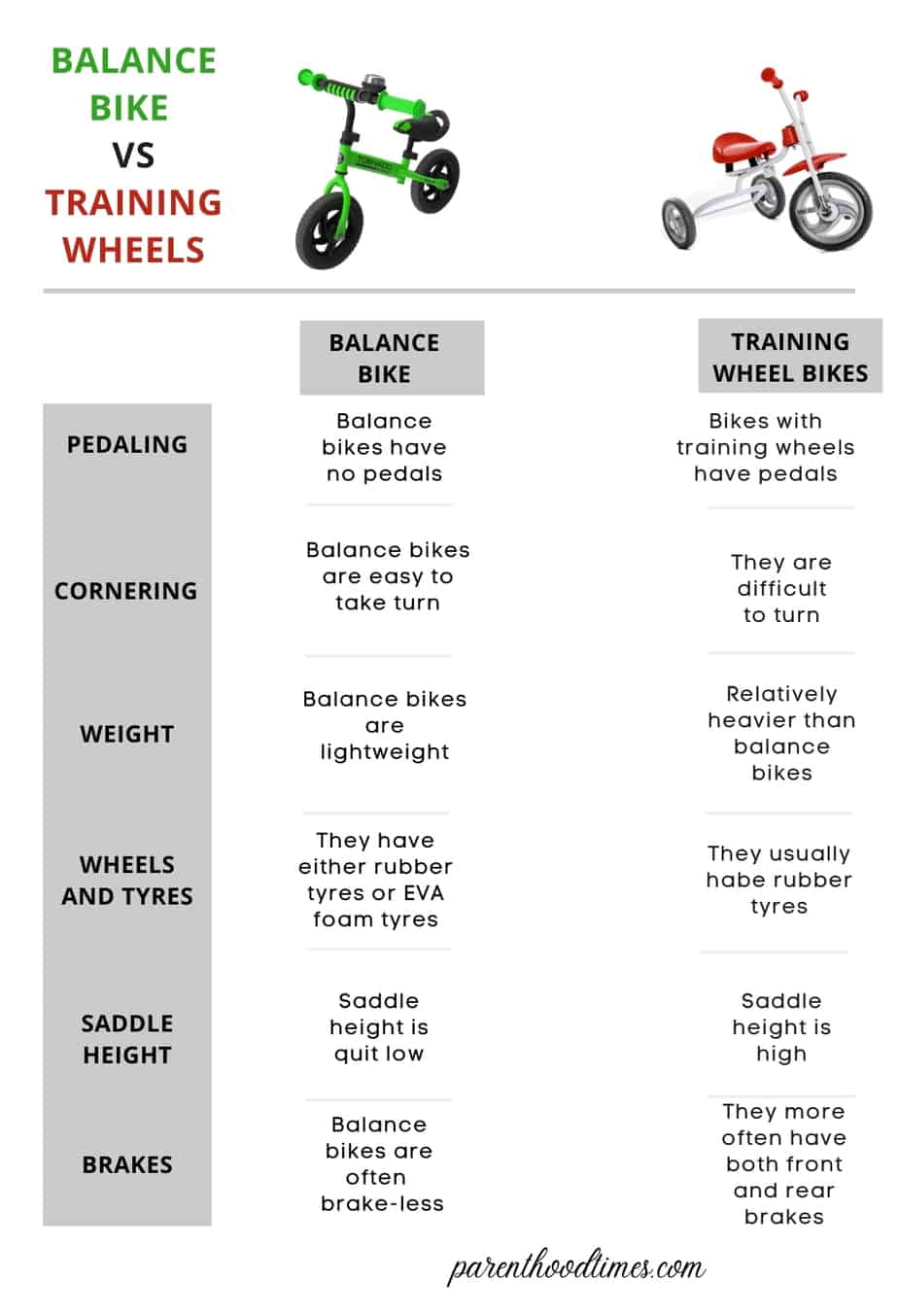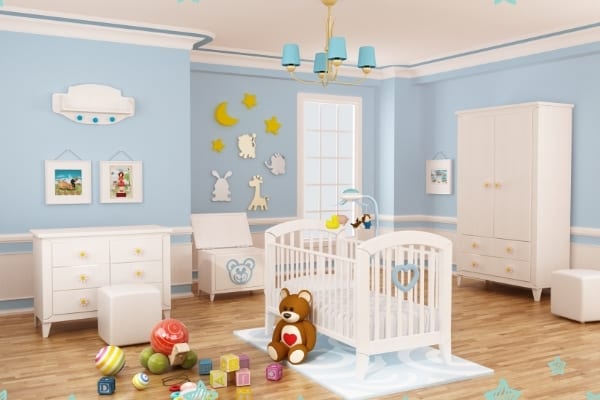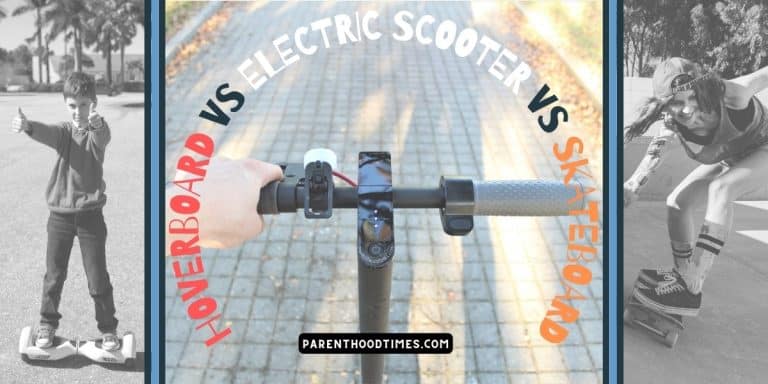Balance Bike Vs Training Wheels: Which One is Best for Toddler?
Learning to ride a bike is not as simple as it seems, as it’s a step-by-step process that may take time. Every child has their own developmental timetable. While some are capable of mastering different skills fast, others take a while. Parents often struggle to choose whether they should get their child a balance bike or a pedal bike with training wheels. So between a balance bike and a bike with training wheels, which one is ideal for a toddler?
A pedal bike fitted with training wheels is a classic option that has existed for many decades. Old-school parents will attest to the fact that pedal wheels were the thing a few decades ago. In recent years, balance bikes are the new kid on the block and almost every parent would like to have a piece of them.
If you’re wondering whether to buy a balance bike or a bike with training wheels, we’ve made things super easy for you. Here is a comprehensive comparison review to help you choose between the balance bikes and pedal bikes with training wheel bikes. Keep reading.
What are Balance Bikes?
Some toddlers take only a few days to learn to ride a bike on their own, while others take months. Riding a bike is all about balance and focus. You can get your kid to learn fast and safely by using a balance bike. Unlike normal bikes, a balance bike doesn’t have pedals.
In short, it’s a bike with everything from the structure, fork, wheels, and handlebars except pedals and stabilizers. Your child’s feet will be on the ground when it’s needed to balance and stabilize the bike. Hence these bikes help the kids in developing the perfect balance before learning how to use pedals.
Balance bikes are best for kids between eighteen months to seven years old. Normally at 18 months, most kids can walk and adapt to a balance bike. Even though these bikes lack a drive train, pedals, and cranks, your kid can easily step on the ground as they maintain a low-profile design.
Unlike training wheels, balance bikes are lighter and easy to control. Hence, your child can steer the bike and speed up slowly. These bikes will give your child confidence and independence to ride a traditional bike in the later stages of their development cycle.
Moreover, balance bikes are suitable for kids who love exploring without needing help from their parents. Kids can apply several tricks, which are essential for motor and coordination skills.
There are notable differences between a balance bike and a normal bike. First, it has a low-profile design that makes the kid feel secure while riding. On the other hand, the saddles of a normal bike are raised for the pedals to have better clearance off the ground. Therefore, your child may feel uncomfortable since he’s propelled up. For a new learner, it can be difficult trying to slow down and gain balance.
What are Training Wheels?
Training wheels are also known as stabilizers. They help stabilize a child’s bicycle wheel by providing support. You can mount them on the sides of your child’s bicycle rear wheel. As the name suggests, they are tools for training your child to ride a bike so they can pedal on their own.
The most important thing is for the child to get a balanced speed. In addition, children need to know when to put their feet down after slowing down. If the bike has a low seat, the kid can put both their feet down with less hassle.
Most parents rely on these wheels even after their children are old enough to ride without them. However, they can wear out with time. And most children lose interest in them before that happens. There’s always that point when you’ll eventually take them off. You can lower the seat’s height if your child is not confident enough. The advantage of this is that your child will put their foot down with ease and feel more confident and safe.
In today’s world, toddlers are exposed to varieties of backgrounds, whether they’re using a balance bike or a pedal bike with training wheels. Whatever the case, they have to be emotionally resilient. On the downside, training wheels are a little wobbly for the first-time user. But once they learn to put their feet down, then it will be a reassurance of safety. Many kids may not need to use the training wheels if they can learn on a balance bike, which offers a fresh experience.
Mostly the process follows putting the wheels, removing the pedals, re-mounting the pedals, pedaling without help, and re-mounting the training wheels up to that point when the kid can balance the speed and put their feet down.
Balance Bike vs Training Wheels: Comparison Chart
Balance Bikes Vs Pedal Bikes with Training Wheels: Which One is Better for Your Toddler?
Any parent would probably want to know whether a balance bike is better than a training wheel. First, it’s important to know that these two products aren’t the same. Here are some features you should look into before making a final decision.
Stability
A bike fitted with training wheels is perched up by two stabilizers. These are higher than the bike’s rear wheel, which may tip your child’s bike on either side because of weight adjustments. When this happens, the bike can wobble, resulting in tipping over on sloped ground.
Moreover, corners are the worst places since the child’s weight will lean towards one side. On the contrary, a balance bike helps your child learn how to maintain balance.
Training wheels can cause bad gear since the bike is much higher off the ground. Your child will have difficulty trying to pedal. Balance bikes help your child progress slowly, just like the normal milestones that start with a crawl, walk, and run.
From our discussion, training wheels help a child learn how to pedal their bike, stay upright, balance the speed, and move between places. However, they often feel awkward to ride, and your child might not actually learn how to ride the bike.
Design
Low profile design makes balance bikes suitable for children of different ages. Training wheels are on the heavier side and not suitable for riding on uneven ground. Also, they are harder to balance than balance bikes. Hence the transition to a normal bike will take time.
Aside from the low profile design, balance bikes are spacious. For this reason, even bigger kids can fit comfortably. You’ll find balance bikes supporting the inches of measurement above the ground.
Because of their kid-friendly structure, balance bikes offer a natural transition for kids learning how to ride.
Riding Experience
A training wheel offers a unique experience to your child, which may not be smooth and enjoyable. Since the wheels are small, your child might feel unsafe riding on different surfaces.
On the other hand, it’s easier to move around with a balance bike due to its lightweight design. Balance bikes allow your child to wander on different surfaces, from the grass to the pavements and more. They can tackle dirt, sand, leaves, and fine soil easily. If you want to raise a curious kid who likes adventure, this is the best option.
Ease of Transition
Since balance bikes are lighter, they are efficient when compared with training wheels. Your child can transition faster when using training wheels.
Kids who ride with training wheels do so in home environments and become fearful of exploring new opportunities. Hence this limits their independence.
Level of Fun
There are many benefits of riding a balance bike since it does not limit your child to exploring places they want to go! Whether it’s riding in skate parks, hiking small mountains, or pumping trucks, there are lots of places for a fantastic experience.
The major reason balance bikes are fun is that their wheel design allows kids to roll over obstacles. However, training wheels need up to four wheels for the bike to slow down and touch the ground. For a balance bike, your child learns how to ride and lean on their side. Even better, they can get out of the uneven ground with less effort. Without a doubt, training wheels are no match to the power provided by the balance bike as the child gets rolling with their tiny legs.
Safety Consideration
Your child’s safety should always be a top priority. Your child needs adult supervision, be it a balance bike or a regular bike with training wheels.
The structure of a bike with training wheels is such that your child has a higher chance of falling, as the pedals will not allow a quick maneuver. Also, your child will find it difficult trying to adjust and stabilize in case of a fall. Worst yet! The pedals can lead to an injury.
Balance bikes offer a safer riding experience than training wheels. With a balance bike, your child will face fewer issues while trying to balance and tilt the bike when riding.
Ease of Steering
Another important aspect of the balance bike is that your child gets accustomed to steering the bike. Hence he can reach optimum limits easily. You’ll find that the majority of the children will jerk on the handlebars when mastering the skill of steering. What this means is that they may fall over and get injured.
The opposite is true for a balance bike since even if the kid falls, it’s not as traumatic as it would be with training wheels.
Ease of Control
Being able to control a bike is an essential part of riding a bike. Training with a balance bike lets your child control the speed, enabling him to stop without tipping over. In this way, the child can shift the weight and lean on either side while maintaining balance.
Your child can also apply different tricks without the risk of falling. Training wheels are not flexible and offer a dull riding experience. Therefore, it limits your kid child’s creativity.
Level of Costs
Understandably, a balance bike is a money saver since you don’t eventually need to buy a bike with pedals. They can continue riding on this bike even when they’ve mastered the skills to ride a bike. You can buy them a new bike when they outgrow the balance bike.
Related Reviews: Best Go-Karts For Kids
Balance Bike Vs Training Wheels
Questions & Answers
At what age should I introduce my kid to a balance bike?
Well, as we noted earlier in our discussion, every child has a different learning curve. Some kids learn fast, while others take time. However, around eighteen months, most children are ready for the roller coaster and explore the outdoors on their own. Of course, parents or caregivers should keep watchful eyes on them!
At what age will a child transition to a bike with a pedal?
Children love adventure and the independence that comes with riding balance bikes. Usually, a child can transition to a pedal bike after learning the basic skills of a balance bike. There’s no age limit, as it all depends on how quickly your child masters the skills. Children by the age of five or six can comfortably cruise with a normal bike.
What happens when the child resists riding a balance bike?
It’s an exceptional case. If your child doesn’t like a balance bike, go for a pedal bike with training wheels. Check out our recommended pedal bikes with training wheels. From there, you can choose one to train your toddler.
Conclusion
The verdict is out! Balance bikes are better than pedal bikes with training wheels since your child can transition quickly to riding a bike with pedals. It is more fun training with balance bikes as your child can apply different tricks and be creative. In addition, a balance bike can offer the best balance even when the child is riding on uneven ground.
There is a general misconception amongst parents that a child requires training wheels before they learn how to ride a bike. Luckily, this is not the case. The design of the balance bike is such that it allows your child to control the speed and touch the ground on their feet easily. Hopefully, you can now decide which one between the two is the best for your child.

